
Much like the games themselves, the Pokemon Trading Card Game also seems to have gone through quite a few changes in its development process, perhaps not as drastic (there’s no unused Pokémon on the cards themselves), but still important enough to be chronicled as they determined the state of the game to this day, and might even be useful to add some little insights about the development of Red and Green. In fact, as Atsushi Nagashima notes in a 2019 Famitsu interview about the TCG development:
(…) At the time, Pokemon Red & Green were still in development, but from how you could collect 151 species of Pokémon, and the game’s turn-based battle system, it was very compatible with the TCG format.” (Translated by Siliconera)
The following card prototypes were all taken from the 1996 August, September, and October issue of CoroCoro Comic and restored by us. You can find a translation of the September and October scans on Dogasu’s Backpack, and the whole set in a somewhat higher res on hirespokemon.tumblr.com
First, we will be looking into the various changes on the card designs themselves.
Change for a $4.99 USD
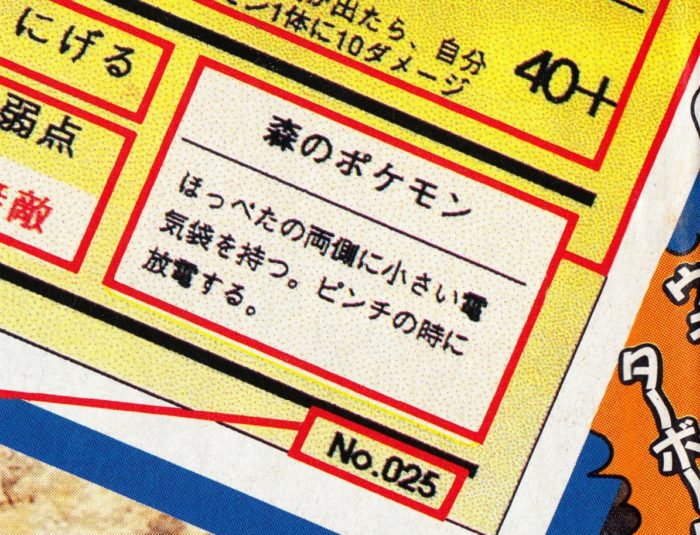
The first major difference between these and the final cards is the inclusion of “habitats” in the flavor text. The habitats visible in the CoroCoro pages are Forest
森 , Grassland 草原 , Urban 町 , Mysterious 不思議な , and Legendary 伝説 . It’s unclear if this was going to be some sort of mechanic in the game itself, but it does seem to be reflected in the background art of the cards.
Could this have been an unimplemented feature from Red and Green’s Pokédex that happened to have carried over? The TCG did begin development before RG released, after all. Interestingly, classifying Pokemon by habitats was also a feature in the Fire Red / Leaf Green Pokédex many years later, Urban (まち
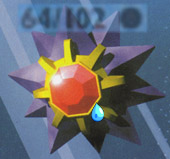
There are no rarity symbols on these cards. Either they didn’t plan to tell people that via the circle, square, or star symbols and were instead just going to opt for holofoil or they simply hadn’t determined which rarities they were going to give to which cards yet. If they were a late addition, that might explain how Starmie somehow ended up as a common.
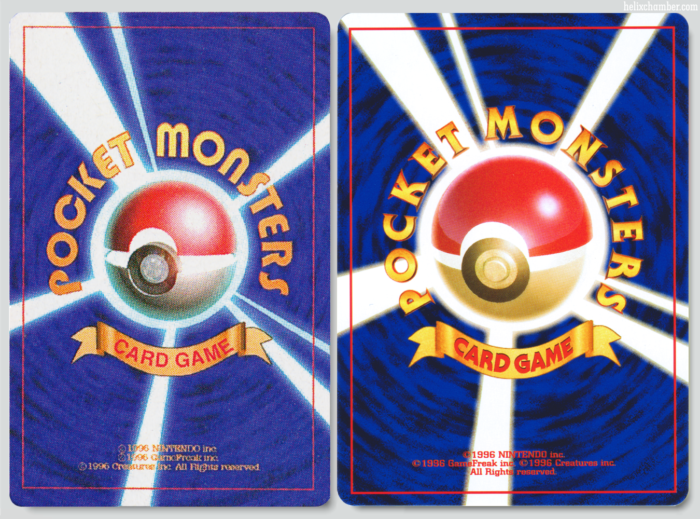
The fonts used on the backs of the cards are slightly different, with the “CARD GAME” text being fairly basic. While basically using the same model by Keiji Kinebuchi, The render of the Pokéball is rougher with the light beams at different angles and the Pokeball button has its top face visible. Copyright text is yellow on the prototype card instead of red and is spaced differently.
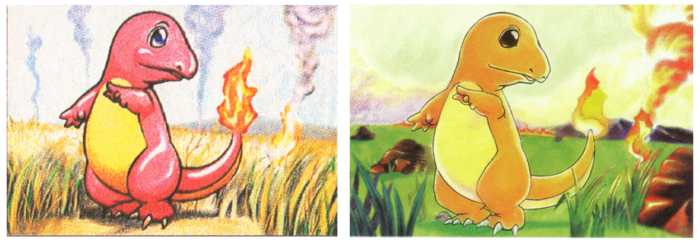
The art itself was noticeably rougher. A significant amount of the Pokemon illustrations just used the Sugimori art with a photo or CG background. In fact, the only other illustrators for the prototype cards shown in CoroCoro were
Keiji Kinebuchi, Mitsuhiro Arita, and Tomokazu Imakuni. Interestingly in the September 1996 issue CoroCoro announced the 102 cards of the first set would’ve featured 20 new Pokémon illustrations, while the final set ended up featuring 31.
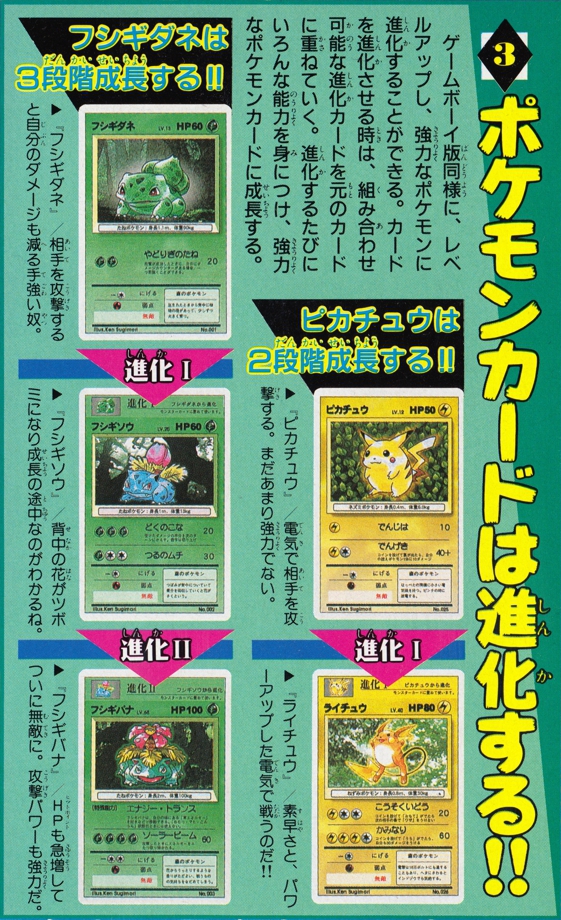
Cards’ outside borders and info boxes are white instead of yellow, and the picture borders are a lighter color of whatever type the Pokemon is instead of yellow. None of the known prototype cards are depicted as holographic, so it’s unknown whether they were considering that at this stage. Evolutions used “進化 I” or “進化 II” instead of “1 進化” or “2 進化” in the “evolves from” text. In what can be presumed are earlier versions, several words use kanji instead of katakana in certain iterations, such as 裏 instead of 「うら」for ‘tails’.
Pokémon Power 「 特殊能力 」text is black instead of red, while “Kilogram” uses “kg” instead of the final “Kg”.
It’s tempting to think that the differences in height and weight might be holdovers from some earlier Pokédex entries in Red and Green, however, they could just be
Inconsistencies in wording, as well as status effect definitions, show that there seemed to have been different stages of development of the card game’s language and features while these prototype cards were being designed.
Resistance is shown with a red font and uses a different word, 無敵 (
Pokédex entries are the same with some decisions changed on whether to use kanji or katakana. Since the original games exclusively used kana for dex entries, the card game’s entries had to have kanji added in accordance with the reading level of the target audience or possibly for space issues.
Next, it’s time to delve into the Pokemon cards themselves.
Missing-in-Active Pokemon
No. 001 BULBASAUR
森のポケモン – Forest Pokemon
1.1m/90kg in
HP dropped from 60 to 40.
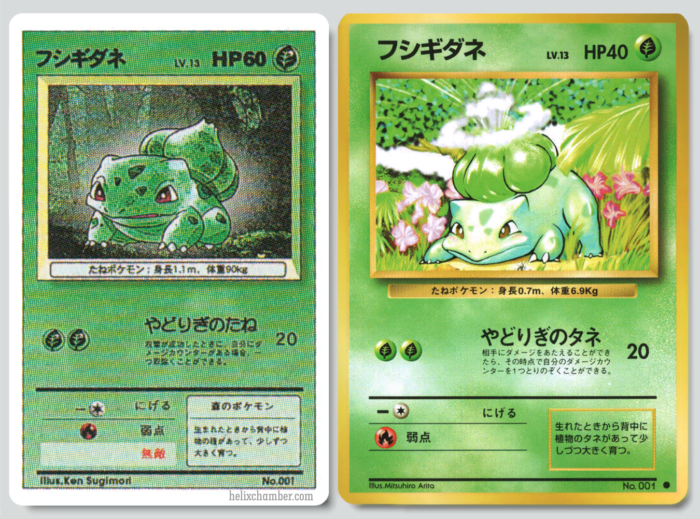
The art for this card was later used for the Japanese release of Erika’s Bulbasaur, while the background itself went on to be used for Ivysaur on its final base set card. In fact, the Bulbasaur family all seem to have backgrounds cropped from one CG forest at different angles. It’s kinda cool to see that they did model more of it than what was just used on Ivysaur’s final card.
No. 002 IVYSAUR
森のポケモン – Forest Pokemon
No height or weight change.
Poisonpowder and Vine Whip are swapped.
Poisonpowder describes the poison status, but doesn’t call it that. It just says “add a damage counter every turn.” It’s possible that status effects weren’t added at this time. It doesn’t call the accrued damage ‘poison counters’ either like Antidote does.

No.003 VENUSAUR
森のポケモン – Forest Pokemon
No height/weight change.
Lv. 68 on the prototype card and LV. 67 on the final (Not so nice for Venusaur).
Energy Trans has some minor grammatical changes. Note that status effects Sleep/Paralysis/Confused are mentioned on this card, unlike Poisonpowder on Ivysaur’s card.
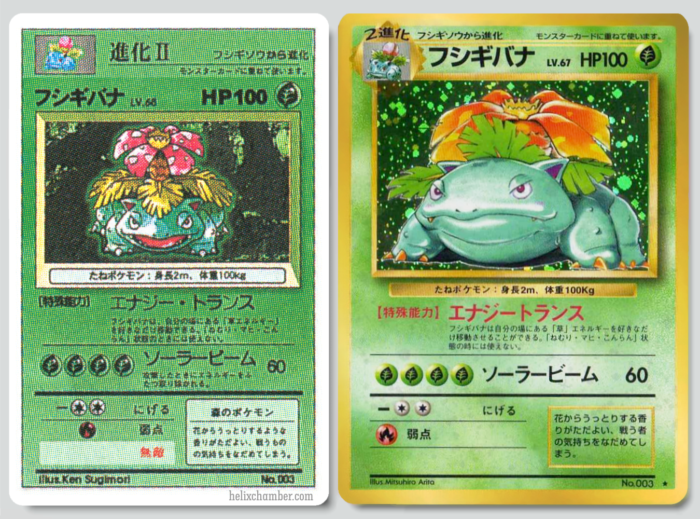
No.004 CHARMANDER
森のポケモン – Forest Pokemon
0.4m and 6.0kg instead of 0.6m and 8.5kg.
LV. 12 on the prototype card and LV. 10 on the final card.
Ember discards an Energy card of any kind while the final requires that it must be a Fire Energy.

No.006 CHARIZARD
草原のポケモン – Grassland Pokemon
100 HP on the prototype card and 120 HP on the final card.
Has Slash (Charmeleon’s move) instead of the Pokémon Power Energy Burn.
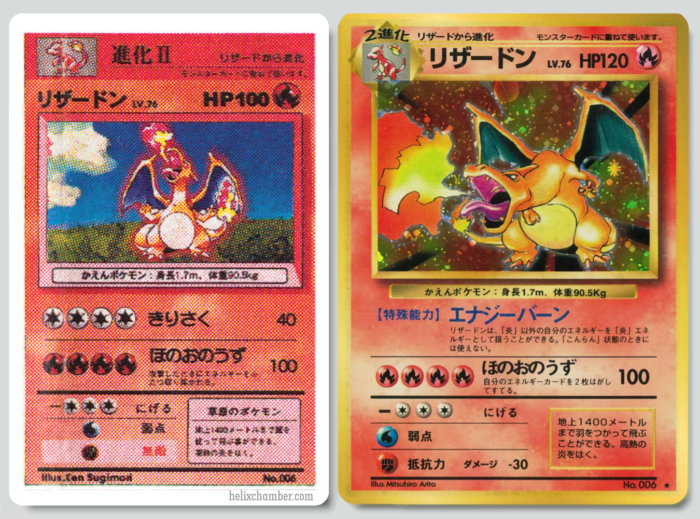
The art for this card was later used for Blaine’s Charizard years later, while that specific background seems to have gone unused even if a similar location can be seen for Ponyta’s background.
No.025 PIKACHU
森のポケモン – Forest Pokemon
50HP (proto) vs 40HP (final).
Nezumi (Mouse) is in katakana on the old card instead of the final hiragana. This card is the only known prototype card that has a katakana species name.
The first move is Thunder Wave (proto) instead of Bite (final) and requires a Lightning Energy.
Thunder Jolt does 40+ damage but the description has the same effect as the final: Pikachu will do 10 damage to itself if you flip a coin and get tails.
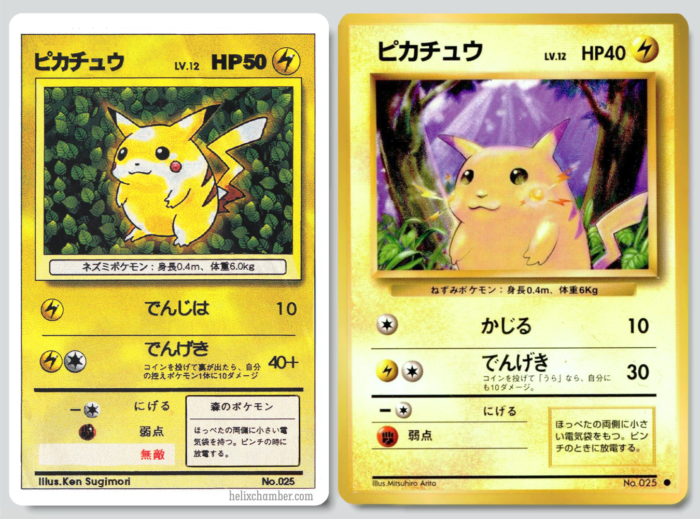

The background was later used for the “Glossy” CoroCoro Promo by Kinebuchi,released with the October 1996 issue, while the art went on to be used for Jungle’s Pikachu (the background art for the Jungle card actually coordinates more with the base set Raichu’s background).
No.026 RAICHU
森のポケモン – Forest Pokemon
All attributes are the same.
The moves are worded slightly differently but their effects are the same.
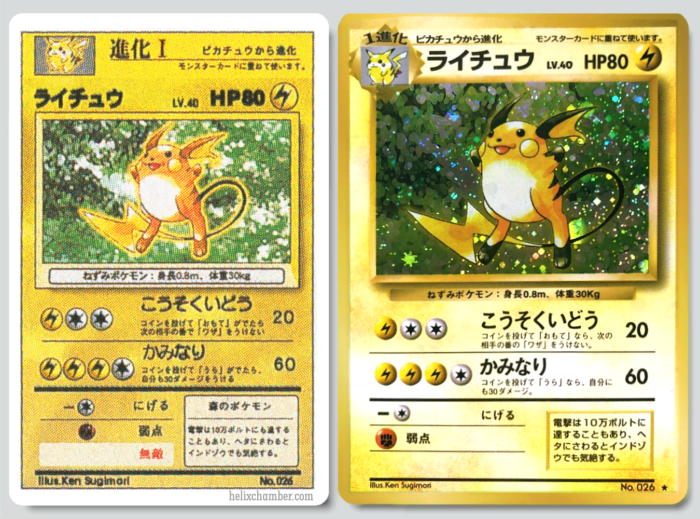
No.035 CLEFAIRY
不思議なのポケモン – Mysterious Pokemon
0.8m/7.5kg (proto) 0.6m/7.5kg (final)
LV. 20 on prototype card and LV. 14 on the final.
Seems to be an earlier card as it uses kanji for game-related terms like “裏” where hiragana is used in the final.
Sing doesn’t call it “the Sleep condition” and seems to instead say that the defending Pokémon falls asleep, but the text is fairly blurry so it’s hard to tell.
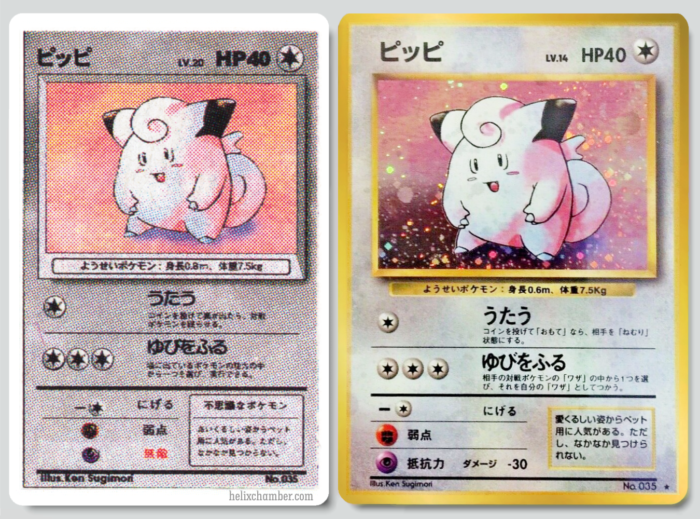
No. 137 PORYGON
町のポケモン – Urban Pokémon
“CG” is changed to katakana for the species name.
LV. 18 with 60 HP on the proto-card instead of LV. 13 with 30 HP on the final.
Has Conversion and Tri Attack instead of Conversion 1 and Conversion 2 in the final. Proto’s Conversion is identical to Conversion 1, but doesn’t state that the effect disappears if the defending Pokemon retreats to the bench like in the final.
Tri Attack has you flip two coins and does 10x the number of heads.
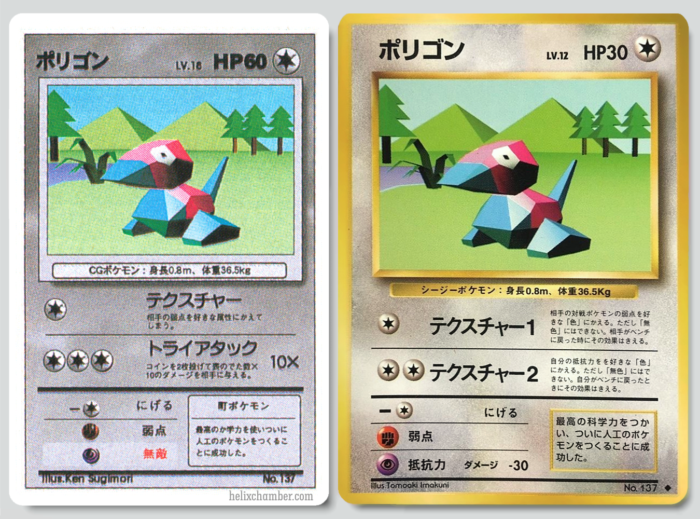
The artwork is erroneously attributed to Ken Sugimori instead of Tomoaki Imakuni, which may imply it was using the RG artwork at some point before this.
No. 150 MEWTWO
伝説のポケモン – Legendary Pokemon
Much like the “Rare Pokemon” (めずらしい) habitat in FRLG.
Mewtwo has 100 HP and is level 70 in this earlier card but has 60 HP and is LV. 53 on the final.
Barrier and Psychic have been swapped. Psychic does 20+ originally instead of 10+, which doesn’t make sense because the description still says that it does 10 damage for each Energy card on the opponent.
Barrier won’t let any attack under 40HP damage hit Mewtwo, while in the final you have to discard an Energy card in order to not be hit by an attack of any power. It appears this original effect later went on to inspire Jungle Mr. Mime’s Invisible Wall Pokémon Power where the effect was inverted (Damage higher than 30 is blocked).
Retreat cost is 4 in the proto and 3 in the final.
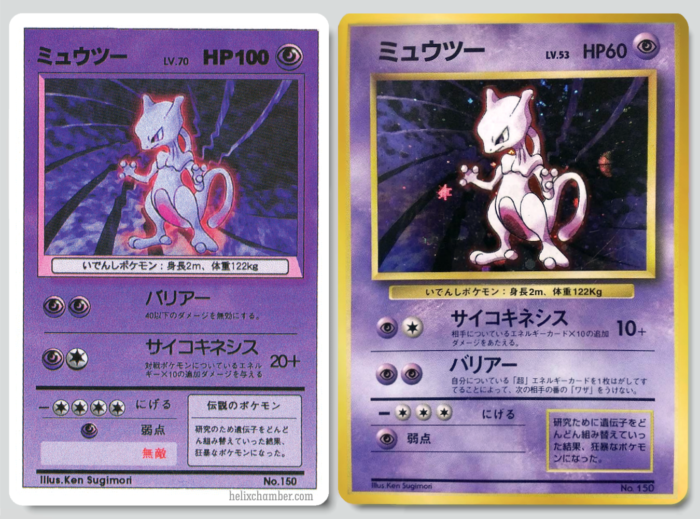
Machamp, Seel, and Poliwhirl are also (barely) visible in another promotional picture (possibly by Kinebuchi) published in the October 1996 issue of CoroCoro Comic, which also seems to feature a slightly different design for the back that now has the same white frame visible on the front.

Luck of the Draw 2 Cards
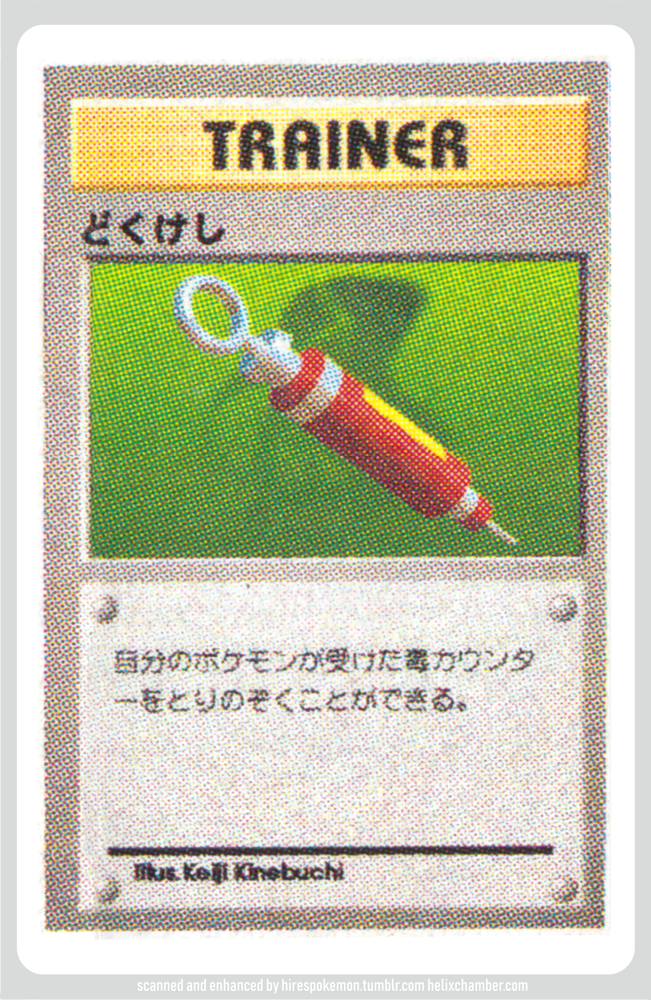
And finally, the early Trainer and Energy Cards. Let’s start with どくけし “Antidote” , a totally unused card! Antidote removes the Poison status effect from your active Pokemon. It’s possible that at some point there were also Parlyze Heal, Awakening, etc. cards but they were likely deemed redundant or added too much bloat to the first set. The Antidote model bears a slight resemblance to the Full Heal model in the final set.
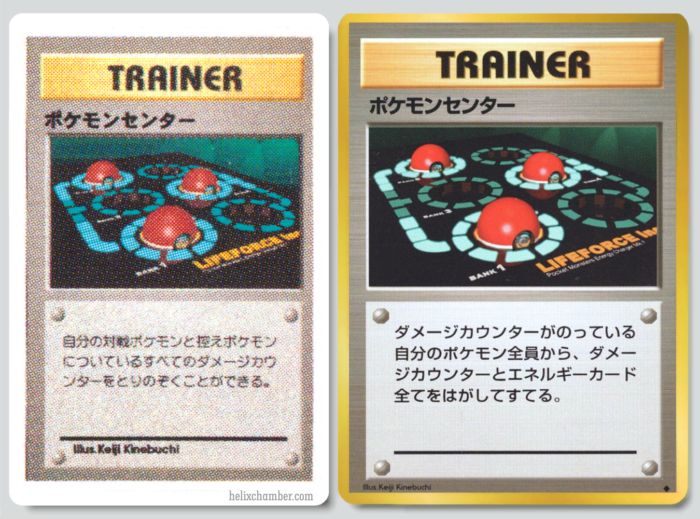
Pokemon Center doesn’t require you remove energy cards in the older version.
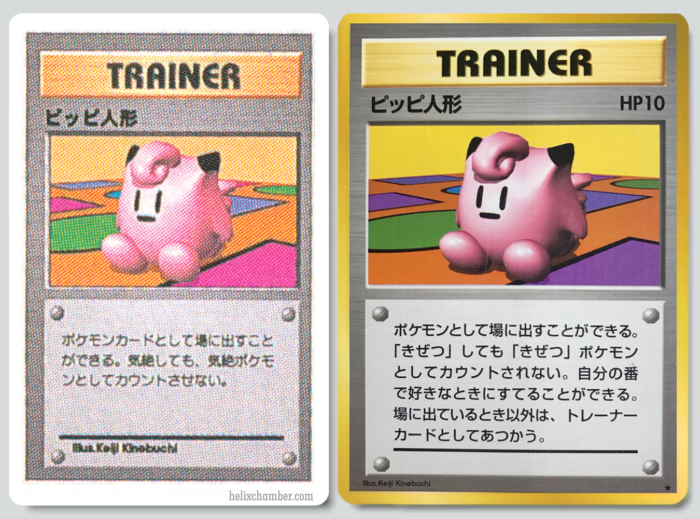
Clefairy Doll has no HP in the prototype. The final version specifies that the doll won’t count as a fainted Pokemon, which made the card actually useful.

Final version of Computer Search requires that you discard 2 cards in order to choose one card from the deck, but this prototype version has no discard requirement. Not even an Ace Spec could balance the old card!

Energy Retrieval‘s final version adds discarding 1 card from the hand as a requirement. It seems that the old Trainer cards were a lot more forgiving, something that was fortunately ironed out in testing. If only they had nerfed Energy Removal in this way…
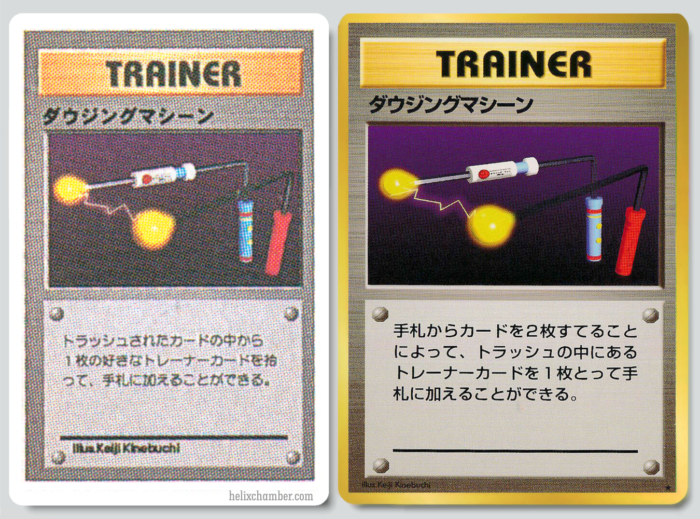
Itemfinder requires you to discard two cards in the final version.
All other text differences (such as the ones found on Energy Removal) are small grammatical changes or reworded text.
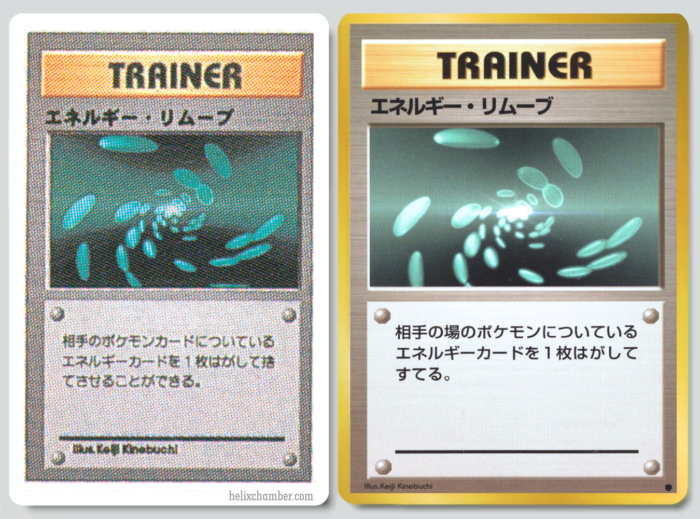
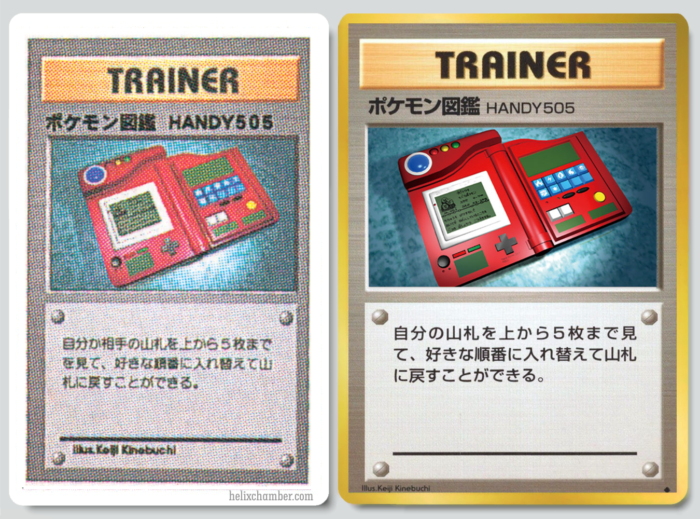
NOTES AND MEDIA
- Prototype Card set download (23,5 Mb)
- TCG director Atsushi Nagashima’s interview for Famitsu [JAP] [ENG]
- Dogasu’s Backpack Pokémon 1996 coverage including September and October CoroCoro Comic translations.
- Zoidsland 1996 CoroCoro scans, August – September – October.
- Just for fun, complete fan-made blank templates and a guideto make your own Proto-cards by Icycatelf on Deviantart
The final Japanese Base Set Cards pictures come from official sources, our scans
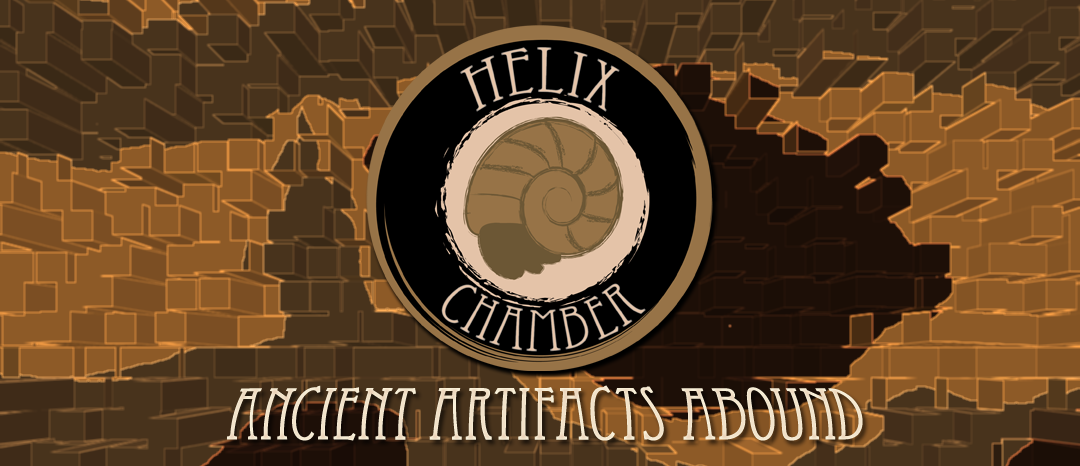


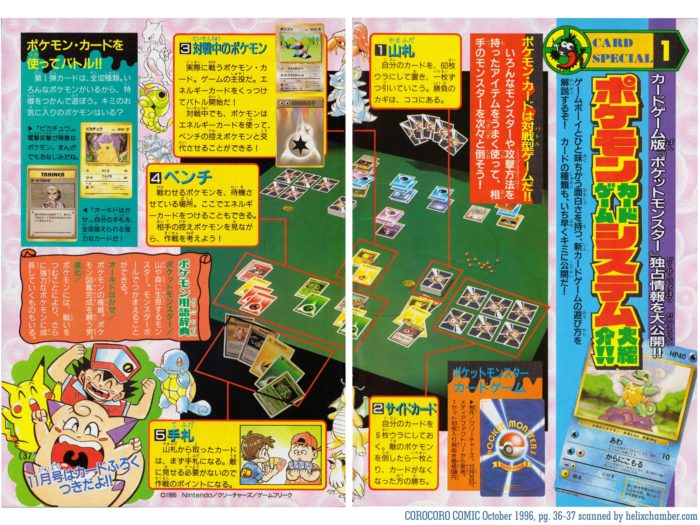
Charizard has such a messy image! So many white spots not cut out/made transparent.
Typo in Porygon card: it is level 12, not 13
O
My
Gosh
I just find this Blog and it,s just incredible, just…i have not words, seriosly. I,m Spanish and i can not xplained me well, but seriosly, this is one of the most increible websites i ever meet about Pokemon. Thanks so so so much for this work. Just unbleiveable.
That’s Machoke, not Machamp at the bottom.
Were these cards ever printed as physical cards, or are these prototype designs only on paper and never actually printed as cards?
I believe that is a machoke barely visible next to the seel and poliwhirl, not machamp!
I hate so much what they did to Mewtwo. The change to Barrier is fair, but the alteration of damage and HP seem like a massive over-reaction. Originally having a four energy retreat cost balances out the card pretty well. If this thing was ever real, all you would have to do is make a house rule that you could only have one Mewtwo in your deck. What a damn shame.